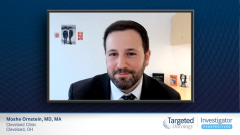
Dosing Considerations for lenvatinib plus pembrolizumab in mRCC
Dr Moshe Ornstein examines dosing considerations for the combination of lenvatinib plus pembrolizumab in clinical practice and how that compares with the findings from the CLEAR study.
Episodes in this series

Transcript:
Moshe Ornstein, MD, MA: When we talk about toxicity, one of the things we really need to talk about is the dosing of these 2 drugs. I want to focus a little less on the dosing of pembrolizumab [Keytruda]. In general, in my practice, I start patients on 200 mg IV [intravenous]. That’s the dosing every 3 weeks regimen. If they’re doing well 3 to 6 months down the road, I’ll switch them to dosing every 6 weeks if that’s their preference, but I like to start them out at the Q3 week dosing. It gives me a better sense as to how the patient is doing symptomatically because they have to come into the clinic every 3 weeks, and it also allows me to give a lower dose of the drug in case there is an immune-related adverse event. How do we manage toxicity in patients who are on this combination? It’s really important to set clear expectations with patients and with fellow team members. I tell patients that the first couple of months on this kind of regimen might be busy. In the first couple of months, we’re figuring out if they’re going to have diarrhea and how to manage it. We’re keeping a very close eye on their labs. I also reassure them that in the clinical trial, most patients needed a dose reduction, and despite most patients needing dose reductions, we still see this incredibly superior efficacy. I generally will start at the 20 mg dose because that’s the dose in the trial. I think in large part, the superior efficacy of this combination is at least in part related to that high dose of lenvatinib [Lenvima] at 20 mg per day. I also don’t hesitate to lower the dose if it’s something that doesn’t sit well with a patient and a patient is struggling with side effects.
If we have these TKI [tyrosine kinase inhibitor] side effects of hand-foot syndrome, diarrhea, etc., there are many strategies to manage them. There are dose reductions, there are dose interruptions, and there are preventative measures. I’ll start at the 20 mg dose. I’ll try to do some of these classic management techniques that we have for TKIs both from a medication perspective but also occasional dose interruptions. I’m not concerned about a dose reduction, and I tell patients if they need it, it’s OK because most patients in the trial needed it and we still see this incredible efficacy. We spoke briefly about IO [immuno-oncology] toxicity, and that’s why I start with the 3-week dosing, and about TKI toxicity, but I want to move briefly into the overlapping toxicities. There are some toxicities where it’s not clear if it’s an immune-related toxicity, or if it’s a TKI toxicity. For those, my general strategy is to hold the TKI, to hold the lenvatinib for a few days, and see if the patient gets better. If those toxicities go away just by holding the TKI, then you know it’s a TKI toxicity and you manage it as such. If those toxicities don’t go away, then it might be an immune-related toxicity where the patient will need steroids. To summarize, most patients in the trial had some toxicity.
In clinical practice, I think it’s important to use the dose that was used in the clinical trial, 20 mg of lenvatinib and then the standard dosing of pembrolizumab. For toxicities that are immune-related, we manage with immune suppressants like steroids. For toxicities that are TKI mediated, we manage with preventative measures, supportive measures, dose interruptions, and dose reductions, and that’s OK to dose reduce if needed. For the overlapping toxicities, I would hold the TKI for a few days, see if it goes away, then it’s likely the TKI. If it doesn’t, then there’s a good chance it’s an immune-related adverse event.
Transcript edited for clarity.









































